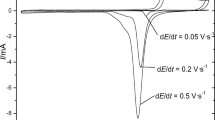Summary
The interfacial tension, between the oil phase containing an ionic surface active agent and the aqueous phase containing an inorganic electrolyte, is a function of the potential difference applied to the two phases from an outer circuit. This phenomenon, the electrocapillarity at oil-water interfaces, was used by the present authors to study the structure of electrical double layers and the interaction between surface active agent ions and counterions. In the present study an amphoteric material, the lecithin, was used as the surface active agent, and its adsorption and dissociation behaviours as well as its interaction with counterions were examined. It was found that the lecithin dissolved in the “oil” phase behaved as the cationic or anionic surface active agent according as the pH of the “aqueous” phase was acidic or alkaline. This showed that the ionic groups of the lecithin molecule are immersed into the aqueous side of the interface. Since the interfacial tension was independent of the applied potential at the interfacial isoelectric point, this point could be measured with a high sensitivity. The ionic species of the inorganic electrolyte in the aqueous phase had a marked influence on the isoelectric point. The reversal of charge spectra thus obtained were found to agree fairly well with that obtained by other authors using electrophoretic measurement.
Similar content being viewed by others
References
Watanabe, A., M. Matsumoto, H. Tamai, andR. Gotoh, Kolloid-Z. u. Z. Polymere220, 152 (1967).
Watanabe, A., M. Matsumoto, H. Tamai, andR. Gotoh, Ibid.221, 47 (1967).
Alton, E. B., Industrial Oil and Fat Products, 2nd ed. (New York 1951).
Davson, H. A. andJ. F. Danielli, The Permeability of Natural Membranes (London 1943).
Anderson, P. J. andB. A. Pethica, Biological Problems of Lipids (London 1955).
Hanai, T., D. A. Haydon, andJ. Taylor, Proc. Roy. Soc., A281, 277 (1964).
Seeman, G. V. F. andB. A. Pethica, Proc. 2nd. Intern. Congr. Surface Activity IV, 277 (1957).
Bungenberg de Jong, H. G., Colloid Science II, byH. R. Kuryt, pp. 259 (Amsterdam 1949).
Author information
Authors and Affiliations
Additional information
With 12 figures
Rights and permissions
About this article
Cite this article
Watanabe, A., Matsumoto, M., Tamai, H. et al. Electrocapillary phenomena at oil-water interfaces. Kolloid-Z.u.Z.Polymere 228, 58–63 (1968). https://doi.org/10.1007/BF02125765
Received:
Issue Date:
DOI: https://doi.org/10.1007/BF02125765




